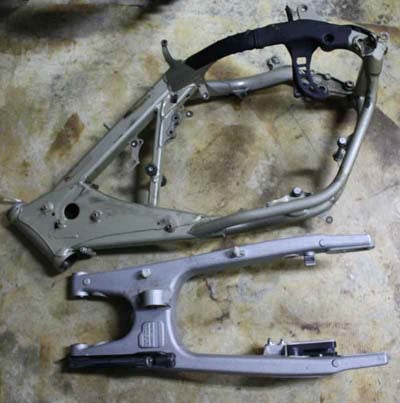 |
| We're upgrading our 380 to a 2005 chassis. |
With our 380 motor nearing completion, it is time to start thinking about putting the bike back together. Instead of just reassembling the bike with all of the stock parts we thought it would be wise to take advantage of some of the technological advances since the year 2000 when our 380 was new.
Since that time, KTM has gone through a few generations of new frames striving for a more rigid chassis with better handling. In addition, the motorcycle industry has come out with some innovative products to increase comfort as well as products with unbelievable durability.
Starting with the chassis we researched what it would take to upgrade the 380 into a newer generation. We came across a desert racer who had raced a 380 in the past but switched to the 300 when the newer chassis became available. After racing the 300 for a while, he missed the great motor of the 380 and decided to stuff the 380 into a 2005-07 chassis, and after that into the latest ’08-style chassis. Both were successful transplants, but after researching parts availability and our budget we decided upon using the 2005-07 style frame and swingarm.
We tried to find a 2008 frame and swingarm, but we didn’t have any luck. Sure, we could have bought a complete 250 or 300, but that wasn’t in our budget … at all. We ended up with an ‘05 frame and swingarm in great condition. While not the latest generation, on the plus side most of our original 380 parts will bolt right up to the ‘05 chassis, saving us the cost of radiators, seat and tank, plastics, etc.
In order to make the motor fit, a few things do need altering. The rear swingarm pivot on the motor was already enlarged from 15mm to the 05 style 17mm during the motor rebuild to fit the larger swingarm pivot shaft. Besides that we will also need to move the motor mounts and expect to run into other minor tweaks, but we know it can be done successfully.
After the chassis upgrade, one of the main things we wanted to combat was the chance of vibration. Although we didn’t notice unruly vibration on our 380, it does vibrate more than a 250cc two-stroke. Hearing about the Fasst Co. Flexx Bars we checked into them and learned they are designed to absorb shock and vibration by using tunable elastomer bushings. There are four different densities of elastomers to choose from that work in conjunction with the articulating bars to help with absorbing engine vibration and terrain changes like G-outs and square-edged bumps.
Fasst Co also makes the Anti-vibration bar inserts which, according to their Web site, use a combination of brass and an elastomer expansion joint to fight vibration. They work by fitting into the end of each bar and absorbing vibration traveling through the bars that would usually end up in your hands. By using both the Flexx Bars and the anti-vibration inserts on the 380, the comfort level should be greatly improved and vibration kept to a minimum. In addition when the terrain changes, we have the ability to tailor the bars damping by swapping out the elastomers for the feel we are looking for.
Another area of the chassis that must be able to deal with the power and torque of the 380 is the driveline. Honestly, it didn’t take much thought on what we were going to use for sprockets - Ironman by Dirt Tricks all the way. We used them on the Project 525 back in 2003 and haven’t bought a new set yet! With a one-year guarantee and the claim they last 15 times longer than OEM, it really was a no brainer. Those claims and our experience speak enough about durability, so it was just a matter or picking the ratio. Stock is 14/52 but we want a little more top end for the desert so we opted for 14/48. For the chain we opted for the latest Regina Z-Ring. The Z-Rings are supposed to offer better flexibility while still keeping the lube inside the chain.
As we begin to wrap up the Project 380, we feel the end is finally getting closer. With an updated chassis, we expect the 380 to have less flex and handle with more precision. The ability to use most of the stock parts really helps with the cost of this project, and it also allows us to spend our budget on items we think will help make the 380 a better bike. The Flexx bars and Anti-vibration inserts should improve the one major nitpick many big-bore riders complain of in vibration. That combined with the articulating arms and tunable elastomer bushings should also allow us to stay in the saddle longer, especially in rough terrain. With our selection of proven Ironman Sprockets, we should gain some top-end speed over the stock setup while extending the life expectancy exponentially. Now we can focus on finalizing our build and getting out on the trails!


 Your Privacy Choices
Your Privacy Choices